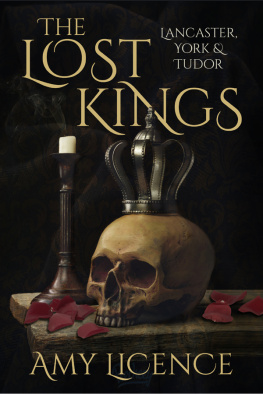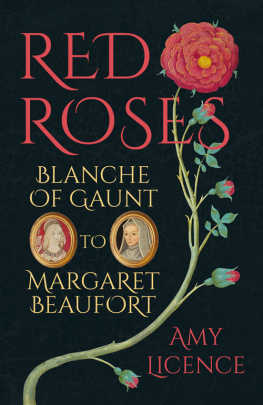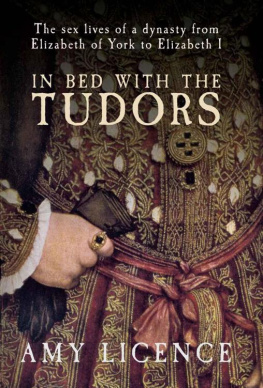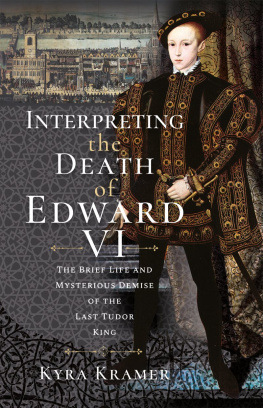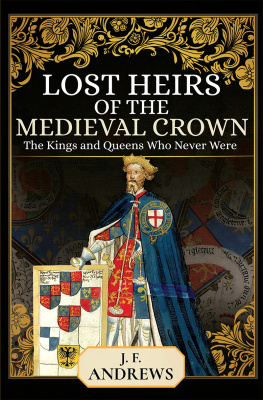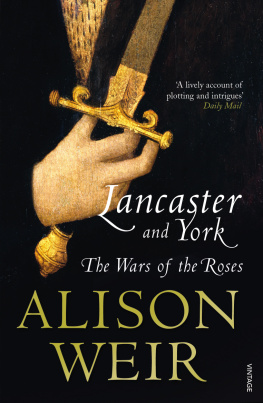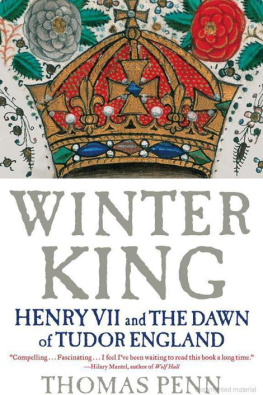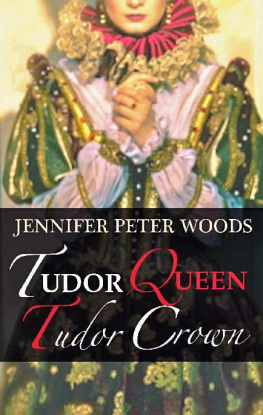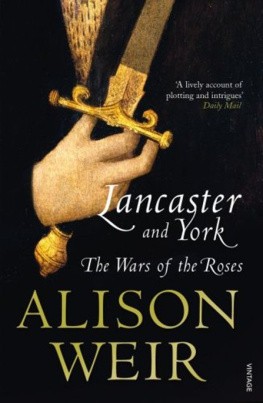Licence - The lost kings Lancaster, York & Tudor
Here you can read online Licence - The lost kings Lancaster, York & Tudor full text of the book (entire story) in english for free. Download pdf and epub, get meaning, cover and reviews about this ebook. City: England, year: 2017, publisher: The History Press, genre: Non-fiction. Description of the work, (preface) as well as reviews are available. Best literature library LitArk.com created for fans of good reading and offers a wide selection of genres:
Romance novel
Science fiction
Adventure
Detective
Science
History
Home and family
Prose
Art
Politics
Computer
Non-fiction
Religion
Business
Children
Humor
Choose a favorite category and find really read worthwhile books. Enjoy immersion in the world of imagination, feel the emotions of the characters or learn something new for yourself, make an fascinating discovery.
- Book:The lost kings Lancaster, York & Tudor
- Author:
- Publisher:The History Press
- Genre:
- Year:2017
- City:England
- Rating:5 / 5
- Favourites:Add to favourites
- Your mark:
- 100
- 1
- 2
- 3
- 4
- 5
The lost kings Lancaster, York & Tudor: summary, description and annotation
We offer to read an annotation, description, summary or preface (depends on what the author of the book "The lost kings Lancaster, York & Tudor" wrote himself). If you haven't found the necessary information about the book — write in the comments, we will try to find it.
Licence: author's other books
Who wrote The lost kings Lancaster, York & Tudor? Find out the surname, the name of the author of the book and a list of all author's works by series.
The lost kings Lancaster, York & Tudor — read online for free the complete book (whole text) full work
Below is the text of the book, divided by pages. System saving the place of the last page read, allows you to conveniently read the book "The lost kings Lancaster, York & Tudor" online for free, without having to search again every time where you left off. Put a bookmark, and you can go to the page where you finished reading at any time.
Font size:
Interval:
Bookmark:


For Tom, Rufus and Robin
Cover image: Shutterstock
First published in 2017
The History Press
The Mill, Brimscombe Port
Stroud, Gloucestershire, GL5 2QG
www.thehistorypress.co.uk
This ebook edition first published in 2017
All rights reserved
Amy Licence, 2017
The right of Amy Licence to be identified as the Author of this work has been asserted in accordance with the Copyright, Designs and Patents Act 1988.
This ebook is copyright material and must not be copied, reproduced, transferred, distributed, leased, licensed or publicly performed or used in any way except as specifically permitted in writing by the publishers, as allowed under the terms and conditions under which it was purchased or as strictly permitted by applicable copyright law. Any unauthorised distribution or use of this text may be a direct infringement of the authors and publishers rights, and those responsible may be liable in law accordingly.
EPUB ISBN 978 0 7509 8500 0
Original typesetting by The History Press
eBook converted by Geethik Technologies
Many thanks go to Sophie Bradshaw, Vanessa Le and the team at The History Press. I have been particularly blessed to have some wonderful friends: thank you to Anne Marie Bouchard, Sharon Bennett Connolly, Jonathan Howell, Magdalen Pitt, Tim Byard-Jones, Geanine Teramani-Cruz, Kyra Kramer, Karen Stone and Harry and Sara Basnett for keeping me sane during the writing of this book. There have been significant others. I am also grateful to my godmother, Lady Susan Priestley, for her kindness and support. And to my family, to my husband Tom and my sons Rufus and Robin; to Paul Fairbrass, Sue and John Hunt. Most of all, thanks go to my mother for her invaluable proofreading skills and my father for his enthusiasm and open mind: this is the result of the books they read me, the museums they took me to as a child and the love and imagination with which they encouraged me.
The Fear of Death
Timor mortis conturbat me
The pretty little church of St Andrews at Wickhampton has overlooked the Norfolk marshland for at least 800 years, probably more. It is situated 4 miles from the coast, on the edge of the Yare Valley, but its dedication to a patron saint of fishermen suggests it may have originally served a community who enjoyed easier access to the North Sea. Wooden vessels could have found their way along the Yare in the south, or the Bude in the north, to the port of Great Yarmouth, to take advantage of a national diet that was rich in seafood thanks to an adherence to the regular fish days of the Catholic calendar: Fridays in particular, and often Wednesdays and Saturdays too. Across the length and breadth of the country, those days saw cooks using almonds or onions, cinnamon or pine nuts to dress their herring and cod, supplied from places like Wickhampton.
Today St Andrews lies quietly among the fields, rebuilt extensively in the fourteenth and nineteenth centuries. Yet for all its long-dead maritime connections, it is remarkable for symbolising another of the key elements of medieval life, an inescapable, all-pervasive, unceasing element as universal as the need for the people to provide and consume food. Adorning the western corner of the north wall are images of a subject that the congregation would have thought about almost as much as their meals, a subject to which the questions of eating and survival were closely allied. Along with many other English churches of the period, St Andrews contains a series of famous memento mori, or paintings depicting the dead. And death, when, where and how it arrived, was nothing short of a medieval obsession.
It is unclear exactly who painted the three eerie-looking skeletons at Wickhampton and the fleshy reflections of their living descendants. The job might have gone to a skilled local painter, who also depicted the images of saints upon other walls of the church, or perhaps an artist drafted in from the royal court, recommended by a wealthy patron. Similar themes appear in churches nearby that were frequented by the well-connected Paston family. However, the artists execution of the six figures here and the details that accompany them leave no doubt as to where he gained his inspiration. The three living and three dead figures are engaged in a hunting scene: a rabbit runs for cover, a dog handler holds leashes and one nobleman holds a falcon upon his outstretched arm. This allows the painting to be identified as an illustration of a widespread legend: that of the Three Living and the Three Dead, originating from the 1280s, and found in places as widespread as France and Germany, Switzerland and Denmark. Although the narratives vary, the most succinct English version is an anonymous alliterative poem of the fifteenth century, possibly by the Shropshire priest John Audelay.
The Three Living and the Three Dead, also called The Three Dead Kings, relates how three kings follow a boar hunt and end up getting lost in the mist. There, in a strange twilight world between earth and the afterlife, they encounter the figures of their ancestors, in varying states of decay, and react with a mixture of fear and bravery. The corpses berate the kings for neglecting their memories and failing to say masses for their souls, reminding the living that their hold on life was brief, and they should makis your mirrour be me, since such as I was you are, and such as I am you will be. The dead also rue their materialistic, lascivious lives, wishing they had lived more simply and spiritually, and warning how rapidly time passes unnoticed. The three living kings heed this macabre message and combine forces to build a church, on whose walls the legend is depicted to the edification of its flock.
But such legends and images were not confined to the walls of churches, to watch over Catholic heads bent in prayer below. The dead were seemingly everywhere, adorning psalters and Books of Hours in lurid colour, creeping into the most quiet, intimate moments of peoples lives. Sixty versions of The Three Living and the Three Dead survive, alongside eighty versions of a later manifestation of the same theme, called The Dance of Death, but corpses also spoke up in other contemporary poems and stories, such as the graphic Disputacione betwyx the Body and Wormes. This unusual dialogue also raises the medieval obsession with the connection between mortality and appetite, as a decaying woman tries to dissuade the worms in her tomb from consuming her, only to be informed that all desires will be overcome by the hunger of others. Although they were ultimately silenced by worms and time, the medieval dead were difficult to ignore, being visceral and three-dimensional, carvings of their rotting corpses glimpsed underneath cadaver or transi tombs, such as those erected for Archbishop Henry Chichele in Canterbury Cathedral and Bishop Richard Fleming at Lincoln. In fact, Chicheles tomb prompted the passer-by to remember you will be like me after you die and was completed before his death, so that he might sit and contemplate it in his final years. It also bore a reminder of his humble origins, a pauper born then to Primate raised, and echoed the imagery of the Disputacione, asserting that he was now cut down and ready to be food for worms.
First, one had to survive birth. With complications arising from delivery, puerperal fever and infection, it has been estimated that mothers faced around a 1 per cent chance of mortality as a result of giving birth, a statistic that marks the process as around 150 times more dangerous than it is today. Spread through the average womans childbearing career, that led to a risk of 6 or 7 per cent. Around one in five children died before they reached the age of 1, and more before their fifth birthday. After this, their life expectancy improved again before another dangerous peak between the ages of 10 and 14. The middle to late teens introduced a new swathe of potential killers, as the medieval child straddled the adult world and engaged in warfare, sexual activity and greater independence.
Next pageFont size:
Interval:
Bookmark:
Similar books «The lost kings Lancaster, York & Tudor»
Look at similar books to The lost kings Lancaster, York & Tudor. We have selected literature similar in name and meaning in the hope of providing readers with more options to find new, interesting, not yet read works.
Discussion, reviews of the book The lost kings Lancaster, York & Tudor and just readers' own opinions. Leave your comments, write what you think about the work, its meaning or the main characters. Specify what exactly you liked and what you didn't like, and why you think so.

